service PONTIAC BONNEVILLE 1996 Owners Manual
[x] Cancel search | Manufacturer: PONTIAC, Model Year: 1996, Model line: BONNEVILLE, Model: PONTIAC BONNEVILLE 1996Pages: 387, PDF Size: 18.71 MB
Page 2 of 387

The 1996 Pontiac Bonneville Owner’s Manual
-
Seats and Restraint Systems ............................................................. 1-1
This section tells you how to use your seats and safety belts prop\
erly. It also explains the “SRS” system.
This section explains how to start and operate your Pontiac.
This section tells you how to adjust the ventilation and comfort co\
ntrols and how to operate your
audio system.
Here you’ll find helpful information and tips about the road\
and
how to drive under different conditions.
This section tells you what to do if you have a problem while driving, such as a flat tire or
overheated engine, etc.
Here the manual tells
you how to keep your Pontiac running properly and looking good.
This section tellp you when to perform vehicle maintenance and what \
fluids and lubricants to use.
This section tells you how to contact Pontiac for assistance and how to get service and \
owner publications.
It also gives you information on “Reporting Safety Defects”\
on page 8-9.
Here’s an alphabetical listing of almost every subject in this manual. You can use it to quickly find
something
you. want to read.
Features and Controls ..................... ; ............................................ 2-1
Comfort Controls and Audio Systems ...................................................... 3-1
. Your Driving and the Road .............................................................. 4-1
ProblemsontheRoad
.................................................................. 5-1
Service and Appearance Care.. .......................................................... 6-1
Maintenanceschedule......... .......................................................... 7-1
Customer Assistance Information ... .#. ................................................... 8-1
Index ........................................................................\
.......... 9-1
ProCarManuals.com
Page 3 of 387
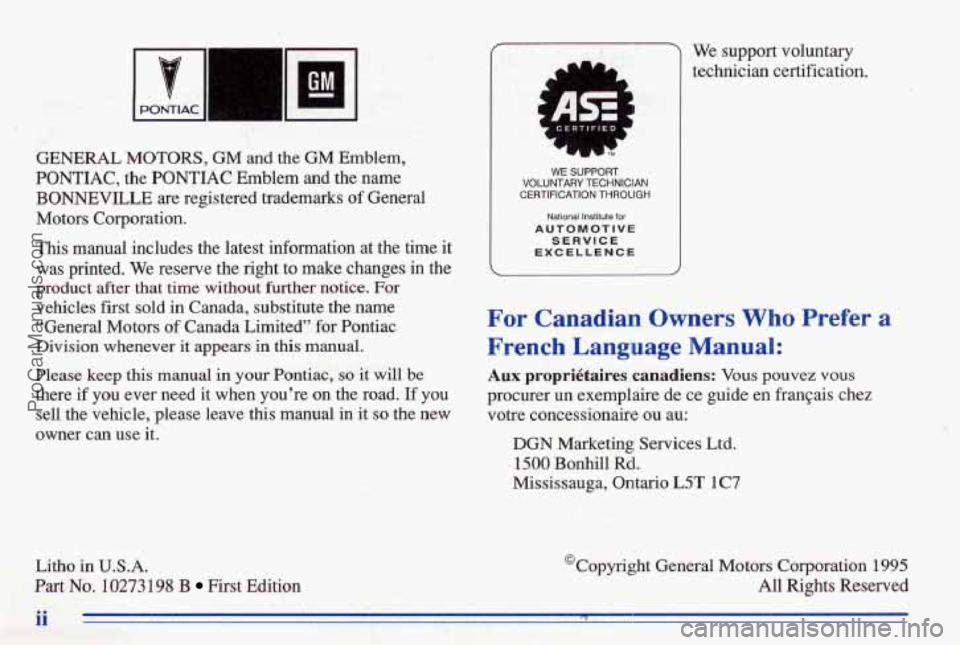
GENERAL MOTORS, GM and the GM Emblem,
PONTIAC, the PONTIAC Emblem and the name
BONNEVILLE
are registered trademarks of General
Motors Corporation.
This manual includes the latest information at the time it
was printed. We reserve the right
to make changes in the
product after
that time without further notice. For
vehicles first
sold in Canada, substitute the name
"General Motors
of Canada Limited" for Pontiac
Division whenever it appears
in this manual.
Please keep this manual in your Pontiac,
so it will be
there if you ever need it when you're on' the road.
If you
sell the vehicle, please leave this manual in
it so the new
owner can
use it.
Litho in U.S.A.
Part No. 10273 198 .B First Edition
CERTIFIED
IL
WE SUPPORT VOLUNTARY TECHNICIAN
CERTIFICATION THROUGH
National Institute for
AUTOMOTIVE SERVICE EXCELILENCE
We support voluntary
technician certification.
For Canadian Owners Who Prefer a
French Language Manual:
Aux propribtaires canadiens: Vous pouvez vous
procurer un exemplaire de ce guide en franGais chez
votre concessionaire
ou au:
DGN Marketing Services Ltd.
1500 Bonhill Rd.
Mississauga, Ontario L5T 1C7
'Copyright General Motors Corporation 1995
All Rights Reserved
ii 1
ProCarManuals.com
Page 27 of 387
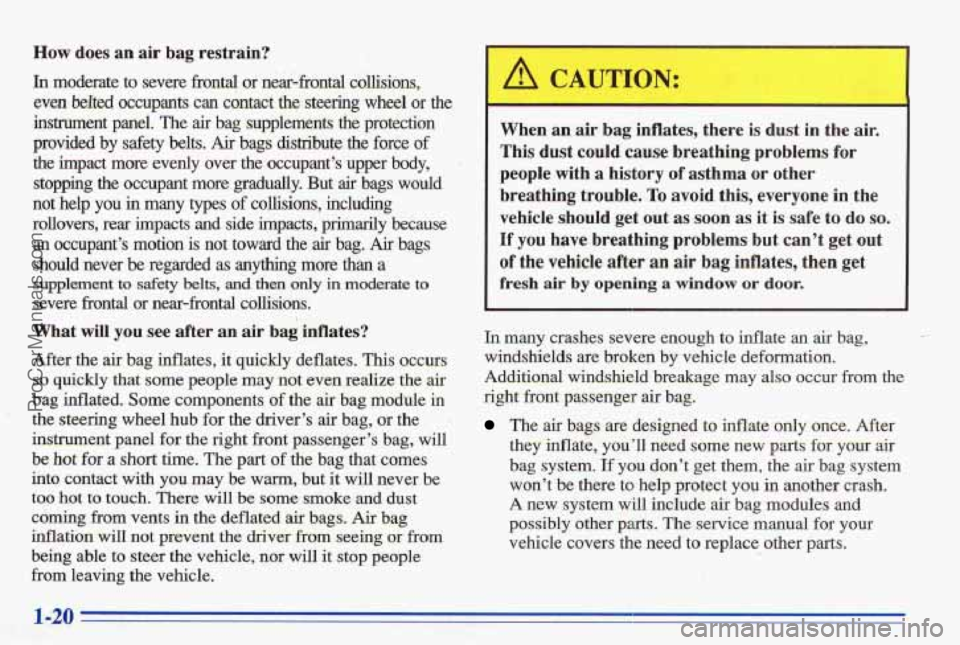
How does an air bag restrain?
In moderate to severe fiontd or near-frontal collisions,
even
belted occupants can contact the steering wheel or the
instrument panel. The air bag supplements the protection
provided by safety belts. Air bags distribute the force of
the impact more evenly over the occupant's upper body, stopping
the occupant more gradually. But air bags would
not help
you in many types of collisions, including
rollovers, rear impacts and side impacts, primarily because
an occupant's motion is not toward the air bag. Air bags
should never be regarded as anythng more than a
supplement to safety belts, and then only in moderate to
severe frontal or near-frontal collisions.
What will you see after an air b& inffates?
After the air bag Mates, it quickly deflates. This occurs
so quickly that some people may not even realize the air
bag inflated. Some components of the air bag module in
. the steering wheel hub for the driver's air bag, or the .
.instrument panel for the right front passenger's bag, will
be hot
for a short time. The part of the bag that comes
into contact with
you may be warm, but it will nev'er be
too hot
to touch. There will be some smoke and dust
coming from vents in the deflated air bags. Air bag
inflation will not prevent the driver from seeing or from
being able to steer the vehicle, nor will it stop people
from leaving the vehicle.
When an air bag inflates, there is dust in the air.
This dust could cause breathing problems for
people with a history
of asthma or other
breathing trouble.
To avoid this, everyone in the
vehicle
should get out as soon as it is safe to do so.
If you have breathing problems but can't get out
of the vehicle after an air bag inflates, then get
fresh air by opening a window or door.
In many crashes severe enough to inflate an air bag,
windshields are broken by vehicle deformation.
Additional
windshield breakage may also occur from the
right front passenger air bag.
The air bags are designed to inflate only once. After
they inflate, you'll need some
new parts for your air
bag system. If you don't get them, the air bag system
won't be there to help protect you
in another crash.
A new system will include air bag modules and
possibly other parts. the^ service manual for your
vehicle covers the need to replace other parts.
1-20 .- _. I ,. .' ProCarManuals.com
Page 28 of 387

0 Your vehicle is equipped with a crash sensing and
diagnostic module, which records information about
the air bag system. The module records information
about the readiness of the system, when the sensors
are activated and driver’s safety belt usage at deployment.
Let only qualified technicians work on your air bag
system. Improper service can mean that your air bag
system won’t work properly. See your dealer for
service.
NOTICE:
If you damage the cover for the driver’s or the
right front passenger’s air bag, they may not
work properly. You may have to replace the air
bag module in the steering wheel or both the air
bag module and the instrument panel for the
right front passenger’s air bag.
Do not open or
break the air bag covers.
Servicing Your Air Bag-Equipped Pontiac
Air bags affect how your Pontiac should be serviced.
There are parts of the air bag system in several places
around your vehicle. You don’t want the system to
inflate while someone is working
on your vehicle. Your
Pontiac dealer and the Bonneville Service Manual have
information about servicing your vehicle and the air bag
system.
To purchase a service manual, see “Service and
Owner Publications” in the Index.
For up to 10 seconds after the ignition key is
turned off and the battery is disconnected, an air
bag can still. inflate during improper service. You
can be injured if you are close to an air bag when
it inflates. Avoid wires wrapped with yellow tape
or yellow connectors. They are probably part
of
the air bag system. Be sure to ‘follow proper
service procedures,’and make sure the person
performing work for you is qualified to do
so.
The air bag system does not need regular maintenance.
ProCarManuals.com
Page 58 of 387
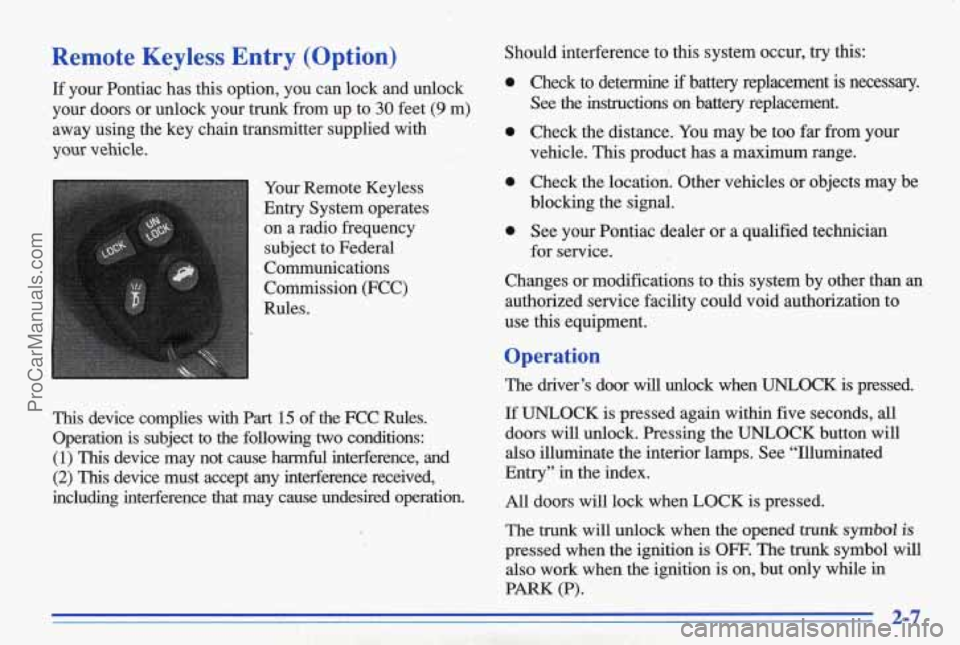
Remote Keyless Entry (Option)
If your Pontiac has this option, you can lock and unlock
your doors or unlock your trunk from up to
30 feet (9 m)
away using the key chain transmitter supplied with
your vehicle.
Your Remote Keyless
Entry System operates on a radio frequency
subject to Federal
Comrinunications
Commission (FCC)
This device complies with Part 15 of the FCC Rules.
Operation is subject
to the following two conditions:
(1) This device may not cause hannful interference, and
(2) This device must accept any interference received,
including interference that may cause undesired operation. Should interference to this system occur,
try this:
0
0
0
0
Check to determine if battery replacement is necessary.
See the instructions on battery replacement.
Check the distance. You may be
too far from your
vehicle.
This product has a maximum range.
Check the location. Other vehicles
dr objects may be
blocking the signal.
See your Pontiac dealer or a qualified technician
for service.
Changes or modifications to this system by other than
an
authorized service facility could void authorization to
use this equipment.
Operation
The driver’s door will unlock when UNLOCK is pressed.
If UNLOCK is pressed again within five seconds, all
doors
will unlock. Pressing the UNLOCK button will
also illuminate the interior lamps. See “Illuminated
Entry” in the index.
All doors
will lock when LOCK is pressed.
The
trunk will unlock when the opened trunk symbol is
pressed when the ignition is OFF. The trunk symbol will
also work when the ignition is
on, but ody while in
PARK (P).
ProCarManuals.com
Page 65 of 387
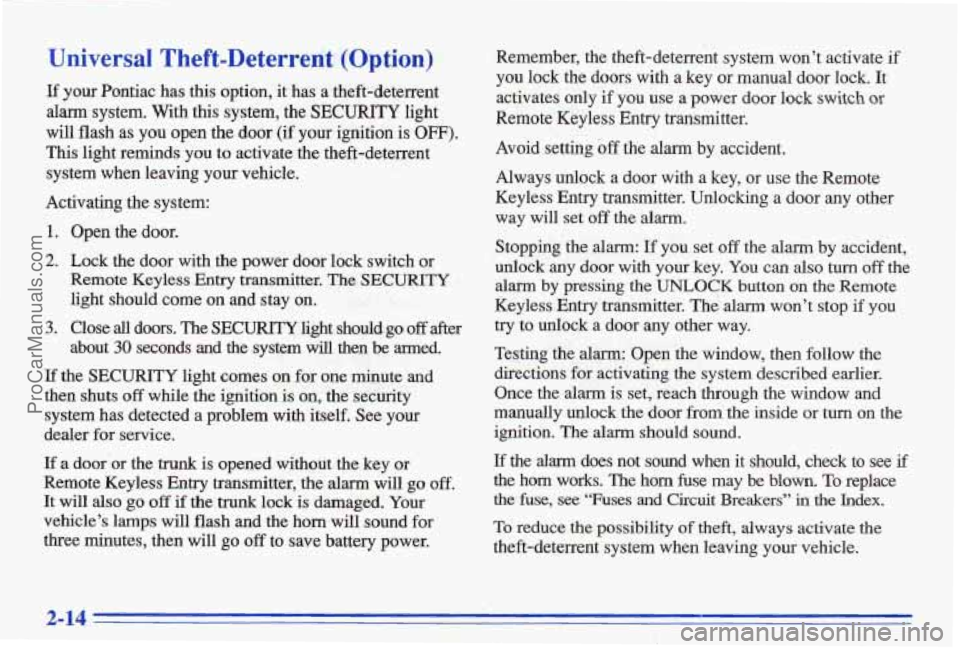
Universal Theft-Deterrent (Option)
If your Pontiac has this option, it has a theft-deterrent
alm system. With this system, the SECURITY light
will flash as you open the door (if your ignition is OFF).
This light reminds you to activate the theft-deterrent
system when leaving
your vehicle.
Activating the
sys tern:
1.
2.
3.
Open the door.
Lock the door with
the power door lock switch or
Remote Keyless
Entry transmitter. The SEC-Y
light should come on and stay on.
Close
all doors. The SECUFUTY light should go afT after
about
30 seconds and the system will then be armed.
If the SECURITY light comes on for one minute and
then shuts
off while the ignition is on, the security
system has detected a problem with itself. See your
dealer for service.
If a door ‘or the trunk is opened without the key or
Remote Keyless Entry transmitter, the
alarm will go off.
It will also go off if the trunk lock is damaged. Your
vehicle’s lamps will flash and the horn will sound for
three minutes, then will
go off to save battery power.
Remember, the theft-deterrent system won’t activate if
you lock the doors with
a key or manual door lock. It
activates only if you use a power door lock
switch ox
Remote Keyless Entry transmitter.
Avoid setting
bff the alarm by accident.
Always unlock
a door with a key, or use the Remote
Keyless Entry transmitter. Unlocking a door any other
way will set
off the alarm.
Stopping the alarm: If you set off the alarm by accident,
unlock
any door with your key. You can also turn off the
alarm by pressing the
UNLOCK button on the Remote
Keyless
Entry transmitter. The alarm won’t stop if you
try to dock a door any other way.
Testing the alarm: Open the, window, then follow the
directions for activating the system described earlier.
Once the alarm is set, reach through the window and
manually uvlock the door
from the inside or turn on the
ignition.
The alarm should sound.
If the alarm does not sound when it should, check to see if
the horn works. The horn fuse may be blown. To replace
the fuse, see “Fuses and Circuit Breakers” in the Index.
To reduce the possibility of theft, always activate the
theft-deterrent
system when leaving your vehicle.
ProCarManuals.com
Page 66 of 387

PASS-Key@ I1
Your vehicle is equipped
with the PASS-Key
II
(Personalized Automotive
Security System)
theft-deterrent system.
PASS-Key
II is a passive
theft-deterrent system.
It works when you insert
or remove the key from
the ignition.
PASS-Key
II uses a resistor pellet in the ignition key
that matches a decoder
in your vehicle.
When the PASS-Key
11 system senses that someone is
using the wrong key, it shuts
down the vehicle’s starter and
fuel systems. For about three minutes, the starter won’t
work and fuel won’t go to
the engine. Lf someone tries to
start your vehicle again or uses another key during
this
time, the vehicle will not start. This discourages someone
fiom randomly trying different keys with different resistor
pellets
in an attempt to make a match.
The ignition key, must be clean and dry before it’s
inserted in the ignition
or the engine may not start. If the
engine does not start and the SECURITY light
is on, the
key may be dirty or wet. Turn the ignition off.
Ciean and dry the key. Wait about three minutes and try
again. The SECURITY light may remain on during this
time. If the starter still won’t work, and the key appears
to be clean and dry, wait about three minutes and try
another ignition key. At this time, you may also want to
check the fuse (see “Fuses and Circuit Breakers” in the
Index). If the starter won’t work with the other key, your
vehicle needs service. If your vehicle does start, the first
ignition key may be faulty.
See your Pontiac dealer or a
locksmith who can service the PASS-Key
Q.
If you accidentally use a key that has a damaged or
missing resistor pellet, the starter won’t work and the
SECURITY light will flash. But you don’t have to wait
three minutes before trying another ignition key.
! 2-15
ProCarManuals.com
Page 67 of 387
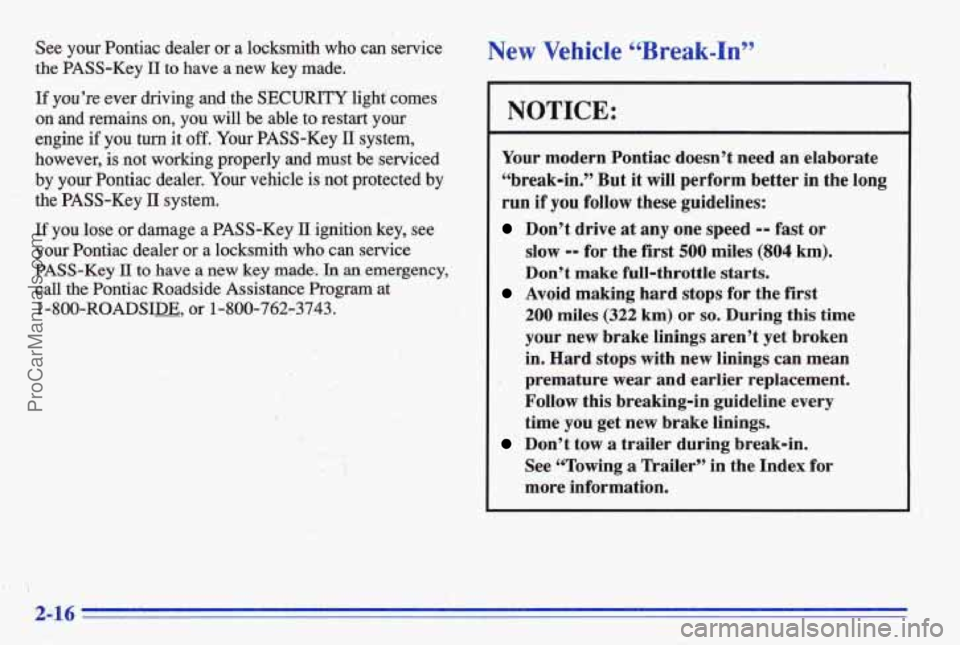
See your Pontiac dealer or a locksmith who can service
the PASS-Key
IT to have a new key made.
If you’re ever driving- and the SECURITY light comes
on and remains on, you will be able.to restart your
engine
if you turn it off. Your PASS-Key 11 system,
however, is
not working properly and must be serviced
by your Pontiac dealer.
Your vehicle is not protected by
If you lose or damage a PASS-Key II ignition key, see
your Pontiac dealer
OT a locksmith who can service
PASS-Key 11 to have a new key made. In an emergency,
call the Pontiac Roadside Assistance Program
at
1-800-ROADSID3, or 1-800-762-3743.
. the PASS-Key II system.
New Vehicle (LBreak-In99
NOTICE:
P
Your modern Pontiac doesn’t need an elaborate
“break=in?’.But
it win perform better in the long
run if you follow these guidelines:
Dm’t drive at any one speed. -- fast or
slow
-- for the first 500 miles (804 km).
Don’t make full-throttle starts.
200 miles (322 km) or so. During this time
your new brake linings aren’t yet broken
in. Hard stops with new linings
can mean
premature wear
and earlier replacement.
Follow
this breaking-in- guideline every
time youmget new brake linings.
See ‘cTowing
a flrailer” in the Index for
more information.
Avoid making hard. stops for the first
Don’t tow a trailer during break-in.
2-16
ProCarManuals.com
Page 69 of 387

START (E): Starts the engine. When the engine st&&
release the key. The ignition switch
will return to RUN
for normal driving.
Note that even if the engine
is not running, the positions
ACCESSORY and RUN are on positions that allow you
to operate your electrical accessories, such as the radio.
Key Reminder Warning
If you leave your key in the ignition, in the OFF
position, you will hear a warning tone when you open
the driver’s door.
NOTICE:
If your key seem stuck in LOCK and you can’t
turn it, be sure
it is all the way in. If it is, then
turn the steering wheel left and right while you
turn the key hard. But turn the
key only with
your hand. Using a tool to force it could break
the key or the ignition switch.
If none of this
works, then your vehicle needs service.
Retained Accessory, Power (Option)
If you have this option, after you turn your ignition OFF
and even remove the key, you will still have electrical
power to such accessories
as the radio and power
windows for up to 10 minutes. But if you open a door,
power is turned off.
Starting Your ,Engine
Move your shift lever to PARK (P) or NEUTRAL (N).
Your engine won’t start in any other position -- that’s
a safety feature. To restart when you’re already ‘moving,
use NEUTRAL (N) only.
NOTICE:
Don’t try to shift to PARK (P) if y& Ponthc is
moving. If you do, you could damage the
transaxle. Shift to PARK (P) only when your
vehicle
is stopped.
2-18
ProCarManuals.com
Page 74 of 387

NOTICE:
Damage to your transaxle caused by shifting out
of
PARK (P) or NEUTRAL (N) with the engine
racing isn’t covered by your warranty.
AUTOMATIC OVERDRIVE
(D): This position is for
normal driving. If you need more power for passing,
and you’re:
- Going less than about 35 mph (56 km/h), push your
- Going about 35 mph (56 h/h) or more, push the
You’ll shift down to the next gear and have more power.
accelerator pedal about halfway down.
accelerator
all the way down.
NOTICE:
If your vehicle seems to start up rather slowly, or
if it seems not to shift gears as you
go faster,
something may be wrong with
a transaxle system
sensor.
If you drive very far that way, your
vehicle can be damaged.
So, if this happens, have
your, vehicle serviced right away. Until then,
you
can use SECOND (2) when you are driving less
than
35 mph (56 kdh) and AUTOMATIC
OVERDRIVE
(0) for higher speeds.
DRIVE (D): This position
is also used for normal
driving, however, it offers more power
and lower fuel
economy than AUTOMATIC
OVERDRIVE (@).
Here are some times you might choose DRIVE (D)
instead of AUTOMATIC OVERDRIVE (@):
- When driving on hilly, winding roads
- When towing a trailer, so there is less shifting
between gears
- When going down a steep hill
ProCarManuals.com